
S/V Dalliance


Dalliance departure from Horta, Faial.
Well here we are again, out in the middle of the Atlantic Ocean, heading to Falmouth, England. We left Horta on the island of Faial on June, 27th at 1415. We both had mixed feelings about leaving. We had met so many new friends that we hated to leave, we knew our way around Horta pretty well and we also knew that this leg of the trip would be more difficult and colder. We kept asking ourselves, “What are we thinking leaving this beautiful paradise to head for cold, rainy England?” But when the time came we were both ready to get back onto the open ocean and head for Falmouth.
This trip so far has been very different than when we sailed from RI to the Azores. We just haven’t been able to get steady winds (either they were really strong or there was no wind at all). Instead of being on a smooth beam reach we are usually close hauled and slogging our way to windward to try to stay close to the rumb line. But, we are having a great time and even meeting new friends along the way.
On Friday, June 30th we made radio contact on the VHF with a sailboat named Sepia. It is owned by a Dutch couple Frank and Marijke and is a 34’ Van de Stadt. In turn, this contact put us in contact with Sandettie, owned by another Dutch couple (Ester and Andre´) who were sailing a steel long keel vessel also bound for Falmouth, UK and who were close to where we were. We have enjoyed maintaining radio contact quite a few times a day with Ester and Andre´. It has especially been fun for Marco because of the Dutch connection. There is also another Dutch boat called Lady Jean who at 0900 and 1800 on 8101 KHz on the SSB (Single Side Band Radio) run a net conference and talk about how things are going, current weather conditions, funny stories etc between many other Dutch boats… This connection has added a new dimension to cruising that we did not have when we sailed the first half of the trip. From RI to the Azores by day 3 the VHF was silent for about 10 days and we rarely even saw another vessel, much less another sailboat. Here we sailed in sight of Sandettie for a whole day and were able to have conversations through out the day on the radio with them. We all plan on getting together in Falmouth and finally meet in person. It is pretty fun to meet new friends in the middle of the ocean.
The routine that we established on the first half of the crossing we continued to implement on this one also. The only bad news is that instead of being on RI time we did switch to UTC time and now my shift from 0100-0600 is pretty much completely in the dark. But at least now Marco gets to enjoy the sunsets, around 2200, and his shift is not completely dark.
Speaking of the dark, it is really amazing to sail in the dark. You really rely on the radar, which we have set to do a sweep every 10 minutes, and the AIS (Automatic Identification System). The AIS is new to us and we are convinced that every sailor planning on sailing off-shore should have one on their boat. At a range of 32nm, it is able to receive transmissions from commercial and passenger ships that are in the vicinity and relay to us their position, their COG (course over ground), SOG (speed over ground), the vessels name, and its heading. Using this information it has been very easy to hail these vessels, which are many times at least a city block long, and let them know that we are in the vicinity. All of the captains that we have spoken to have been very accommodating to us and usually will steer a few degrees in one direction or another to clear us safely. One captain even asked Marco if it he wanted him to pass on our port side and if 1 or 2 miles was enough. Marco quickly asked for the 2 mile margin. You think 2 miles is pretty far away but when you have a cargo ship that is as long as your neighborhood street, 2 miles seems awfully close. Another time, Marco hailed a captain and asked if he could see us on his radar and the captain replied, “Wait one moment while I turn my radar on.” This is another reason we feel that every offshore boat should have an AIS as part of their standard equipment.


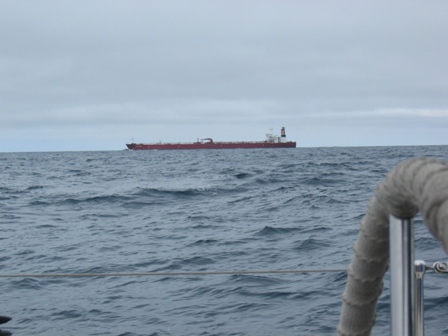
The passing tanker was also clearly seen on radar, and it was comforting to know that he had also seen us as well from quite a distance. Generally we see them before they pick us up on radar, as the size of radar target between their hull and our radar reflector, is the difference between a city block and a hub cap. VHF radio contact with their bridge has been without exception courteous and cooperative in negotiating a safe pass between the boats in any weather.
Sailing at night you also get to see some truly beautiful sites. One night Marco was on watch and all of a sudden 3, what looked liked glow in the dark torpedoes, came darting towards our boat. He said it unnerved him a little but then realized that they were dolphins disturbing the bioluminescent dinoflagellates in the water which caused them to emit a bright blue/green light. This continued each night for a couple of days. One night when I was on watch there had to be over 25 dolphins swimming around the boat all glowing. It was truly spectacular!!!!!
On this part of the voyage we had the opportunity to meet up close and personally with Sperm Whales. The first meeting, I was adjusting the monitor wind vane, (self steering) and I happened to look on the starboard side of out boat and all of a sudden a Sperm whale surfaced inches away from the boat. It really took me by surprise and I screamed really loud (like the scream from the movie Psycho) then when I realized what was happening I started yelling WHALE, WHALE!!!! Marco was sleeping and came running up on board. Mean while, after I screamed the first time, the whale spy hopped about 5 ft. from the stern of the boat and just looked at me. I think it was just as startled as I was and was wondering, “What the heck was that”? When Marco arrived in the cockpit the whale stuck its enormous head out and looked at us a couple more times. It was truly a breath taking (literally and figuratively speaking) experience.
On the second episode, I was once again in the cockpit and I heard this really loud sound from a blow hole. I looked over and on the port side of our boat 4 Sperm Whales were swimming right toward our boat. One of the whales surfaced in front of the bow and the other 3 (one mom and 2 young whales) swam under our boat. I screamed once again and Marco ran up and had the opportunity to see the whales, now on the starboard side of the boat, dive deep. AWESOME!!!!
Sperm Whales are the largest of the toothed whales. They dive deeper and for longer than any other whale (hundreds or thousands of feet and for as long as 40 minutes). They also have the greatest difference in size between males and females. Males are about 60’ long where females are around 36’. Our Sperm Whale sightings were all females. Sperm Whales get their name from an unusual shared characteristic, spermaceti (literally meaning, ‘sperm of the whale”), which is a liquid wax that fills the spermaceti organ, in their heads. The origin and function of the spermaceti is uncertain. Spermaceti was commercially valuable in the 18th and 19th centuries because of its use in making candles, and later as a base for cosmetics, thus Sperm Whales were the subject of intense hunting. Herman Melville’s classic tale, Moby Dick, was also based on a Sperm Whale. Sperm Whales forage mainly on or near the bottom of the ocean for their food. Their main food sources are large and medium-size squid. One Sperm Whales stomach was found to contain a giant squid 40 feet long that weighed 440 pounds. They also eat octopuses, rays, sharks and other bony fish. Sperm Whales feed regularly throughout they year and consume about 3-3.5 percent of their weight each day. Males typically weigh about 120,000 lbs and females weigh around 55,000 lbs. That is a lot of squid!!!
During this portion of the transatlantic sail we also fished. In the first portion of the sail (RI to Azores) we were hesitant to fish because there were so many dolphins around that we were afraid that we would inadvertently catch one. However, we asked around and our fears were put to rest, no one had ever caught or heard of a dolphin going after a lure before. So we fished. Our good friend, Todd Clark, gave us some lures that were specifically intended for deep sea fishing and sure enough I caught a beautiful tuna with one of them. We didn’t end up keeping it however because it was too large and Andre’ and Ester on board Sendettie told us they didn’t eat fish, (we would of shared with them) so we returned him to the ocean.
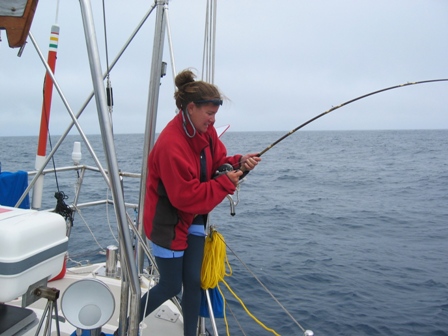

So as you can see we kept quite busy along the 12 day sail. But it wasn’t until the last day and night of our trip that we really felt as if we have sailed across the Atlantic Ocean and are worthy to call our selves trans-Atlantic sailors. We were approximately 150nm off shore and a low pressure system that was traveling from the west to the coast of Ireland was getting close to our area. Through the weather fax, Commander Weather and the Dutch Net with the Grib Files we were made aware that this system contained 30 knot winds that would begin in the afternoon and continue until midnight. Marco and I prepared the boat for a stormy night by removing the dorades, putting a deep reef in the mainsail, attaching the storm jib and securing everything below. By about noon the winds were steady at 25 kts and the waves were approximately 10-15 feet tall. Dalliance was sailing along beautifully and we had an average of going 6 kts on a beam reach. By 1600 however the winds started exceeding 25 kts and the wave height grew rapidly. So, for the rest of the night Marco and I sailed Dalliance with winds that topped at 42 knots (considered a Gale) and the waves were approximately 20-30 feet tall. At times when we were in the trough between 2 waves all you could see was 2 walls of water in front and behind the boat. For the rest of the evening our average speed was 7.6 kts and at one point our GPS recorded our average speed at 13.4 kts for a ˝ hour duration. We did a great deal of surfing down the waves during this time. We were also in constant contact via the VHF with Sepia and Sandettie throughout the entire storm which was also reassuring. It was a truly amazing experience. There was not a single instant that we felt as if we were in danger or out of control. Dalliance proved herself once again and I have to say that we weren’t too bad ourselves. I have to admit that when midnight came along however, Marco and I said, “O.K., we know we can handle this kind of weather now, you can leave.” It wasn’t until 0300 though that the storm finally began to abate and we were able to relax a little bit.

As you can see, at sea one develops more than just a casual interest in the weather. We have several sources of weather information even while underway. We have used the meteorologists at Commanders Weather Routers, to help determine the best weather window to start a passage , as well as to consult them via satellite telephone en route to discuss any new weather developments. Weather faxes from NOAA or the UK have also been critical at keeping abreast of the weather systems, to find the most favorable weather as well as to help avoid more stormy areas. The Navtex receiver is especially useful here in Europe, where each country's weather service broadcasts their local reports, as well as any navigational concerns or emergencies, in English no less. Finally fellow cruisers at sea are happy to share their weather information via the VHF for nearby sailors or the shortwave radio for beyond 20 miles or so, to help get a clear picture of the conditions ahead.
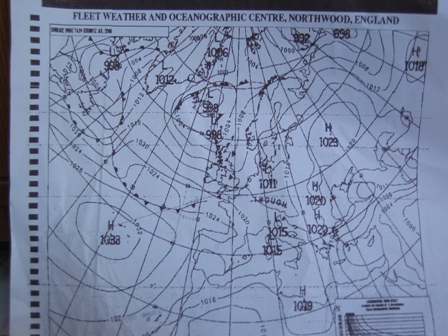
On July 9th at 1430 we arrived in Falmouth, England, a little tired but very excited. WE NOW HAVE SAILED ACROSS THE ATLANTIC OCEAN!!!!!!!
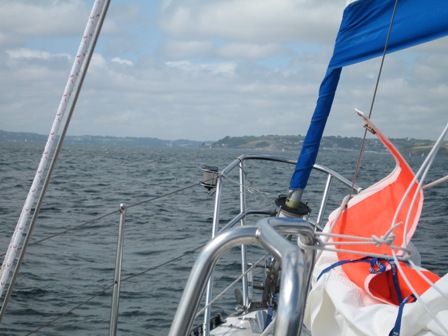
Our landfall was celebrated that evening in an English pub with our new Dutch friends. The shared experience of a gale at sea, forged a unique friendship made at the high seas.
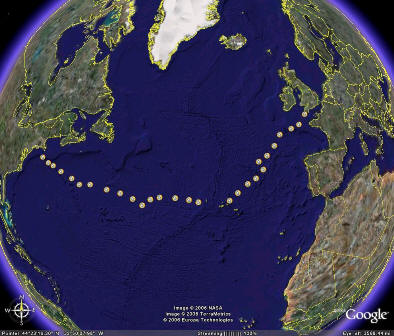
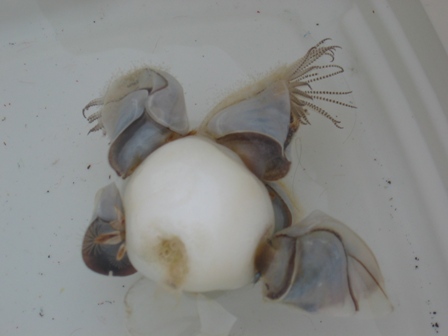
Quiz: Can anyone identify the organism pictured above. We have seen thousands of these floating on our passage between the Azores and the UK. The white central portion is about the size of a walnut. The winner(s) will be posted on the web and have a chance at world fame. Please email us your answers, and sources of your information. If you feel that you would like to hide the degree of your genius, or just hide the fact that you actually look at this website, please let us know that you would like to remain anonymous.